All About Violin
Strings
Article In progress -
Version 0.9 - March 26th 1999
A String is like car tyre
 Strings
can be compared to car tyres. Strings directly influence the performance of your
instrument. They must "adhere" and vibrate well - be tough and very
responsive. Like car tyres they must work as a whole and they must match each
other, so that when passing from one string to another, no difference should be
noted in string tension and tone. Don't try one make for the G, another for the
D, A, and E - a totally different kind for each string in most cases leads to a
mismatch in feel and performance. Cheap Violins come with the worst tyres. These
are used simply in order to say that the instrument is complete and functions (
albeit with a screech !) . Cheap Chinese strings are also far too thin - just
rip these off and buy some new strings. Anything will sound twice as good. If
you buy Dominants or better, your Chinese violin will sound at least three times
as good ! ( Good tyres will make the car drive better and feel better ! ).
Strings wear out and need replacing well before they burst. If you keep them
clean they last longer, though.
Strings
can be compared to car tyres. Strings directly influence the performance of your
instrument. They must "adhere" and vibrate well - be tough and very
responsive. Like car tyres they must work as a whole and they must match each
other, so that when passing from one string to another, no difference should be
noted in string tension and tone. Don't try one make for the G, another for the
D, A, and E - a totally different kind for each string in most cases leads to a
mismatch in feel and performance. Cheap Violins come with the worst tyres. These
are used simply in order to say that the instrument is complete and functions (
albeit with a screech !) . Cheap Chinese strings are also far too thin - just
rip these off and buy some new strings. Anything will sound twice as good. If
you buy Dominants or better, your Chinese violin will sound at least three times
as good ! ( Good tyres will make the car drive better and feel better ! ).
Strings wear out and need replacing well before they burst. If you keep them
clean they last longer, though.
Tension
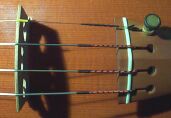 Tension
is good. Violin playing and the sound itself is all about tension. ( Good
tension that is ...not negative tension ! ) Bass strings must be quite thick to
produce a fat sound, yet they must not be too tense in order not to
"squash" the vibrations into the body of the instrument. A tense
string apparently produces a louder sound close by, but at a distance it conveys
less body and roundness. Higher notes need more tension. E strings are usually
made of metal because the tension is so high. This works well for projecting
clarity and tone in high ( 5th position plus ) registers, but is a major
disaster when played as an open string. ( zzzzzzzzzz or ZZZZZZZZZZ is heard ).
Around the 1920s when metal Es were invented and recordings were beginning to
take place, the E string would resonate too much for the equipment that
Violinists stopped playing open Es altogether. This persisted until more recent
times, and Nathan Milstein, recording for Deutche Grammophone uses open Es quite
often ( though with great sensitivity and care ! ). Tense strings can be played
nearer the fingerboard ( because the string and tone will not break ). Try a
slow bow on a fat gut core D near the fingerboard, and you'll hear a rude noise
! When bowing with a similar speed and weight on a low tension string you must
move closer to the bridge - or if you want to stay near the fingerboard you must
bow faster and lighter not to spoil the vibrations. A good violinist knows all
about these 3 external bowing factors that alter tone : speed, weight,
point-of-contact. They are all dependent on string tension.
Tension
is good. Violin playing and the sound itself is all about tension. ( Good
tension that is ...not negative tension ! ) Bass strings must be quite thick to
produce a fat sound, yet they must not be too tense in order not to
"squash" the vibrations into the body of the instrument. A tense
string apparently produces a louder sound close by, but at a distance it conveys
less body and roundness. Higher notes need more tension. E strings are usually
made of metal because the tension is so high. This works well for projecting
clarity and tone in high ( 5th position plus ) registers, but is a major
disaster when played as an open string. ( zzzzzzzzzz or ZZZZZZZZZZ is heard ).
Around the 1920s when metal Es were invented and recordings were beginning to
take place, the E string would resonate too much for the equipment that
Violinists stopped playing open Es altogether. This persisted until more recent
times, and Nathan Milstein, recording for Deutche Grammophone uses open Es quite
often ( though with great sensitivity and care ! ). Tense strings can be played
nearer the fingerboard ( because the string and tone will not break ). Try a
slow bow on a fat gut core D near the fingerboard, and you'll hear a rude noise
! When bowing with a similar speed and weight on a low tension string you must
move closer to the bridge - or if you want to stay near the fingerboard you must
bow faster and lighter not to spoil the vibrations. A good violinist knows all
about these 3 external bowing factors that alter tone : speed, weight,
point-of-contact. They are all dependent on string tension.
Lastly, another point about string which are more tense ( say
when comparing synthetics to gut core ) I notice a weakly placed 4th finger will
sound better on the tense strings than on the gut strings. In general,
Intonation is more brilliant and true with high tension strings, though with gut
core strings, intonation can be more forgiving. Vibrato too sounds warmer on gut
core strings, and one has to add a softer tough of the finger pad to tense
strings, but apply a firmer grasp with lower tension strings. Low tension
strings will often be easier to "pull" with the bow - they will
require less bowing effort than tight ones. When bowing détaché with metal
strings, one needs to "work" the wrist, arm and hand in a more supple
way, in order to maintain extra adherence. On a soft gut core string, the
adherence is very easily attained.
The Perfect string
 The
perfect string never needs to be tuned. It has a very warm sound, full and round
! It sounds unforced and very sweet, capable of quiet and loud dynamics. It also
never whistles, or squeaks when your bow is not quite perpendicular or when the
string is new. It is very accurate both in 5ths and all other intervals. The
string's surface is so smooth when you change position, and the string itself is
flexible and soft - with a wide amplitude in vibration. The string catches the
bow hairs very easily, and is pulled or displaced very easily by the bow, with
almost no down force needed to assure a full contact. The open strings sound
just as sweet as a fingered note - and lastly - the string never ever breaks
during a concert ! Unfortunately, the perfect string doesn't exist, even if many
violinists constantly keep an eye out for anything new on the market that will
one day match all these criteria ! I have been playing the violin for 25 years,
as a full time student, then in Professional Symphony and Chamber Orchestra,
then on to Quartets and even as Soloist at times, and now as a Conservatoire
teacher. The following article reflects my personal views on several strings.
For the strings I have not tried - I have asked others to write something
positive about them.
The
perfect string never needs to be tuned. It has a very warm sound, full and round
! It sounds unforced and very sweet, capable of quiet and loud dynamics. It also
never whistles, or squeaks when your bow is not quite perpendicular or when the
string is new. It is very accurate both in 5ths and all other intervals. The
string's surface is so smooth when you change position, and the string itself is
flexible and soft - with a wide amplitude in vibration. The string catches the
bow hairs very easily, and is pulled or displaced very easily by the bow, with
almost no down force needed to assure a full contact. The open strings sound
just as sweet as a fingered note - and lastly - the string never ever breaks
during a concert ! Unfortunately, the perfect string doesn't exist, even if many
violinists constantly keep an eye out for anything new on the market that will
one day match all these criteria ! I have been playing the violin for 25 years,
as a full time student, then in Professional Symphony and Chamber Orchestra,
then on to Quartets and even as Soloist at times, and now as a Conservatoire
teacher. The following article reflects my personal views on several strings.
For the strings I have not tried - I have asked others to write something
positive about them.
Don't use metal - It will sound like metal
( take this with a pinch of salt !! )
A few Violin Soloists have used metal strings - The Quartetto Italiano did
for precise intonation. Even Thomastik claim Leonid Kogan used their Metal brand
! However, nearly all top class soloists do not. ( Excluding Electric Violinists
). Myself, I have always hated metal strings ! When I was 10 years old, I
remember trying a school violin on one occasion. It had metal strings, and I
thought the sound was ghastly. I think I was rather spoilt, as my parents were
able to afford whatever equipment I fancied ! Never again for 24 years did I
ever use anything else apart from Thomastik Dominant or Pirastro Eudoxa. The
only other strings I have ever really tried out were Kaplan gut, and recently
Zyex by D'Addario ( who now own Kaplan I believe. ) Oh yes, I have also used
Olive by Pirastro, but usually preferred the lighter weight Eudoxas. For very
short periods in the past I have actually bought and used a set of Prim strings
( which are a soft / rounder sounding metal string ) and I think I bought a set
of Thomastik metal strings, which were very bright, and very precise about
conveying good intonation especially, say in double stopping scales on the A and
E. Nowadays, there are new metal strings, such as Helicor, which claim to sound
remarkably like gut core.
New synthetic "computer" made strings have
arrived !
Recently, because a shop recommended a set of Zyex, ( and, well, I had been
wondering for some time what to do about my Eudoxas going out of tune because of
continuing climatic changes and general humidity ), I tried them out.
Unfortunately, I hadn't realized how tense these "space technology"
Zyex core strings were. I couldn't play anything softly. The lightest touch of
the string would produce a booming clear and resounding tone ! However, I
immediately appreciated their stability in tone and in maintaining pitch, but
they could not compete with the Eudoxas for dynamic range and tone quality. Also
their high tension meant chord playing was much harder, even if this would have
been solved by experience and growing used to the tighter strings. Anyway, since
a large number of synthetic strings has appeared on the market, and a Russian
Violinist friend of mine suggested Corelli strings, I decided to search for an
alternative.
Pirastro : Obligato - This sounds interesting !
After making a few enquiries to violinists who use Pirastro Obligato strings,
I decided to try them. Yesterday evening I put them on, and today have been very
impressed with the result. The sound is warm, and quite similar to Eudoxa Gut
strings in General. It's not quite as beautiful, but this was to be expected
with a synthetic core string. However, some qualities surpass the Eudoxa ; the
pitch is stable and robust ; the technical accuracy and purity of tone is very
even, and generally clearer in higher positions ; intonation is marginally more
accurate ; the E string is the best I have ever tried ; gold to bring out the
highest notes, but with some qualities of a carbon based core E string ;
softness on the open string. On the whole they are playing very nicely, and have
barely had a chance to settle !
Let's compare some well known strings
Now for some notes about the different makes of strings. These are personal
impressions ( from a violinists point of view. ) I cannot guarantee keeping the
science 100% accurate - but I am sure specific tensions and characteristics are
all relative, because a high bridge can create more tension in the strings.
Also, instruments themselves have differing characteristics, and a string may
work well on a modern instrument, yet "strain" an older one.
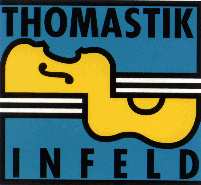
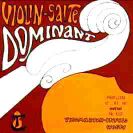 Thomastik
: Dominant
- These are warm sounding strings with good general characteristics. I
usually insist all students start out with these strings, because they have a
much warmer and rounder sound than metal strings. They are not the most
expensive string either. I also think more dynamics can be obtained with these
strings, and a much broader tonal range is also possible. These strings will not
sound as loud as metal strings, but they do cost 2 times the price. However, as
they sound 3 times better, and can be obtained in small sizes ( for half size
violins, for example ) I tell my young students to invest in these high quality
professional strings. I think even Perlman uses these on his Stradivarius !
These strings lose their tension and become flat for quite a few hours after
putting them on, but after 3 days they are quite stable, and keep well in tune.
They are made of a sort of nylon called Perlon ( a name used only by Thomastik
), and the core of the string is made up a many filaments or strands of Perlon.
The exterior is aluminum winding, which is quite susceptible to corrosion
through sweat and perspiration. If not cleaned ( as all strings should be -
except Chromcore ) within 6 months or less the surface smoothness will be lost,
as tiny holes eat into the aluminum surface of the string. Alcohol is a good
substance to clean the string with, but take care not to spill any onto the
belly of your violin. My impression is that the many independent filaments of
Perlon give the sound a broadness and fullness which is very satisfying. The
strings are thick, full of bass tone and round in sound, and not too tense.
These are very popular strings, and sale statistics say more of these strings
are purchased than any other type. FINAL MARK 9/10
Thomastik
: Dominant
- These are warm sounding strings with good general characteristics. I
usually insist all students start out with these strings, because they have a
much warmer and rounder sound than metal strings. They are not the most
expensive string either. I also think more dynamics can be obtained with these
strings, and a much broader tonal range is also possible. These strings will not
sound as loud as metal strings, but they do cost 2 times the price. However, as
they sound 3 times better, and can be obtained in small sizes ( for half size
violins, for example ) I tell my young students to invest in these high quality
professional strings. I think even Perlman uses these on his Stradivarius !
These strings lose their tension and become flat for quite a few hours after
putting them on, but after 3 days they are quite stable, and keep well in tune.
They are made of a sort of nylon called Perlon ( a name used only by Thomastik
), and the core of the string is made up a many filaments or strands of Perlon.
The exterior is aluminum winding, which is quite susceptible to corrosion
through sweat and perspiration. If not cleaned ( as all strings should be -
except Chromcore ) within 6 months or less the surface smoothness will be lost,
as tiny holes eat into the aluminum surface of the string. Alcohol is a good
substance to clean the string with, but take care not to spill any onto the
belly of your violin. My impression is that the many independent filaments of
Perlon give the sound a broadness and fullness which is very satisfying. The
strings are thick, full of bass tone and round in sound, and not too tense.
These are very popular strings, and sale statistics say more of these strings
are purchased than any other type. FINAL MARK 9/10

 Pirastro
: Eudoxa
- ( Sold separately - only the E has an envelope ). These strings make
a beautiful sound, which is not large and blatant in quality but extremely
refined, and very capable of huge changes in tone and dynamics. They can be
played softly and also very loudly, when bowing very near the bridge. They have
a flexibility and range in tone which is more suited to chamber music than to
solo work with an orchestra. In short they are the best. However - the bad news
: They never stay in tune : The A string whistles sometimes for a day or two
before it settles down. These string take 3 days to break in, sometimes, and on
occasion, they can break even on the shelf ! Just try tuning your A when the
room, and your hands are humid, and the temperature of the instrument has risen.
Now leave your violin ; the room cools down, the sun shines in, the string dries
up and tightens to one tone higher and when you come back to play the next day
you find the string has snapped under the excessive tension. These strings
absorb and release humidity very quickly, hence the difficulty in keeping them
in tune. Just how bad this is depends on the climate in which you live. If you
perspire, you will have to clean these string every evening after you play.
Pirastro sell a special string cleaner which you should use. If you are able to
quickly touch up your tuning frequently, then you might like these string.
However, sometimes, when you are performing in public, you might find a few
embarrassing and frustrating moments as the string looses tension and lowers in
pitch. The hardest string to tame is the A, as the D and G strings are less
tense. For this reason certain Russian players use a Gold plated E, a chromecore
A and 2 Eudoxa on the Bass strings. They therefore use 2 fine adjusters on the A
and E. This used to be the classic string setup for Russian pros, but I think
synthetic strings like Corelli have provided an alternative solution. Eudoxas
are the most refined strings in existence, though they are very delicate and
temperamental to tune. A flat A string will ( before sounding flat ) become Dull
and change its tone, so that it no longer sounds cantabile and "on
top". One day I might go back to these strings, though, as nothing else is
quite as rich and satisfying to play as a gut core string. The thicknesses I
used were 17 ( thick ) D string. 16 ( thin ) G string - for a tighter bass ; 13
or 13 1/4 for a ( thin ) A string. The thinner string makes for a readier and a
tighter A string, which is batter than having a fat A string next to a metal E (
which is much thinner ). Intonation will seem flat on a thicker string, so the
thinner the A, the better the compatibility with the E. Of course a chrome A is
even more compatible with an E. Pirastro writes : " EUDOXA set the standard
for all string manufacturers worldwide, creating such a vital power and
wonderful sound picture which carries to the last row even of the biggest
concert halls of today. " Indeed, these strings have the most refined sound
imaginable. Final mark 9/10.
Pirastro
: Eudoxa
- ( Sold separately - only the E has an envelope ). These strings make
a beautiful sound, which is not large and blatant in quality but extremely
refined, and very capable of huge changes in tone and dynamics. They can be
played softly and also very loudly, when bowing very near the bridge. They have
a flexibility and range in tone which is more suited to chamber music than to
solo work with an orchestra. In short they are the best. However - the bad news
: They never stay in tune : The A string whistles sometimes for a day or two
before it settles down. These string take 3 days to break in, sometimes, and on
occasion, they can break even on the shelf ! Just try tuning your A when the
room, and your hands are humid, and the temperature of the instrument has risen.
Now leave your violin ; the room cools down, the sun shines in, the string dries
up and tightens to one tone higher and when you come back to play the next day
you find the string has snapped under the excessive tension. These strings
absorb and release humidity very quickly, hence the difficulty in keeping them
in tune. Just how bad this is depends on the climate in which you live. If you
perspire, you will have to clean these string every evening after you play.
Pirastro sell a special string cleaner which you should use. If you are able to
quickly touch up your tuning frequently, then you might like these string.
However, sometimes, when you are performing in public, you might find a few
embarrassing and frustrating moments as the string looses tension and lowers in
pitch. The hardest string to tame is the A, as the D and G strings are less
tense. For this reason certain Russian players use a Gold plated E, a chromecore
A and 2 Eudoxa on the Bass strings. They therefore use 2 fine adjusters on the A
and E. This used to be the classic string setup for Russian pros, but I think
synthetic strings like Corelli have provided an alternative solution. Eudoxas
are the most refined strings in existence, though they are very delicate and
temperamental to tune. A flat A string will ( before sounding flat ) become Dull
and change its tone, so that it no longer sounds cantabile and "on
top". One day I might go back to these strings, though, as nothing else is
quite as rich and satisfying to play as a gut core string. The thicknesses I
used were 17 ( thick ) D string. 16 ( thin ) G string - for a tighter bass ; 13
or 13 1/4 for a ( thin ) A string. The thinner string makes for a readier and a
tighter A string, which is batter than having a fat A string next to a metal E (
which is much thinner ). Intonation will seem flat on a thicker string, so the
thinner the A, the better the compatibility with the E. Of course a chrome A is
even more compatible with an E. Pirastro writes : " EUDOXA set the standard
for all string manufacturers worldwide, creating such a vital power and
wonderful sound picture which carries to the last row even of the biggest
concert halls of today. " Indeed, these strings have the most refined sound
imaginable. Final mark 9/10.

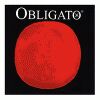 Pirastro
: Obligato - These are a
new synthetic-core material version of the Eudoxas or Olives. The type of sound
and feel of the string is very similar to the Eudoxas. The tension is higher
than Eudoxas, but not quite as much as the Medium brand Zyex. The transition
from Eudoxas is not too awkward, and, of course, like most synthetics, these
strings will always stay in tune. As the tension is slightly higher, I have
reduced the curvature of my bridge and the height, because when playing chords,
these strings will not bend or "give" as much as the Eudoxas. They
will tend to stay taught and straight. The E string is a Gold plated string -
perhaps the very best ( and most expensive ) I have ever come across. Other
synthetic strings tend to use a carbon based E string - which plays a sweeter
open E, but doesn't have the projection and transparency of the Gold strings
especially in the higher ranges. The Obligatos come as separates ( apart from
the E ) and are slightly more expensive than Eudoxas. The G is a thick string -
the D is quite thin ( surprising when it's usually the fattest of the lot ! ) ,
and the A fairly thick. The thin D works surprisingly well with good readiness
and body to the sound. Obligatos have a very fine and smooth aluminium winding
on the outside - which is also susceptible to slight wear and tear if you do not
coat the string grooves of your bridge with a soft graphite pencil. This eases
the friction of the string over the bridge as you tune - and is a procedure
recommended by Pirastro for these strings. Final verdict - this is a
professional high quality string. The tonal range is 80% of Eudoxas, as is the
tonal beauty. In general I would say the sound "emulates" Eudoxas
well, which can be considered an acceptable loss in quality when you consider
the reliability of the string staying in tune. Because these strings bend less
when you play chords - I found chord playing was harder, especially due to the
tense A - getting around it meant flattening my bridge even further, so chords
are more "united". Pirastro writes : " Now available new PIRASTRO®
OBLIGATO draws the "gut line" further into musician´s future
interpretations and activities. From technical point of view, OBLIGATO is said
to be a quantum jump in string technology. " Final mark 9/10
Pirastro
: Obligato - These are a
new synthetic-core material version of the Eudoxas or Olives. The type of sound
and feel of the string is very similar to the Eudoxas. The tension is higher
than Eudoxas, but not quite as much as the Medium brand Zyex. The transition
from Eudoxas is not too awkward, and, of course, like most synthetics, these
strings will always stay in tune. As the tension is slightly higher, I have
reduced the curvature of my bridge and the height, because when playing chords,
these strings will not bend or "give" as much as the Eudoxas. They
will tend to stay taught and straight. The E string is a Gold plated string -
perhaps the very best ( and most expensive ) I have ever come across. Other
synthetic strings tend to use a carbon based E string - which plays a sweeter
open E, but doesn't have the projection and transparency of the Gold strings
especially in the higher ranges. The Obligatos come as separates ( apart from
the E ) and are slightly more expensive than Eudoxas. The G is a thick string -
the D is quite thin ( surprising when it's usually the fattest of the lot ! ) ,
and the A fairly thick. The thin D works surprisingly well with good readiness
and body to the sound. Obligatos have a very fine and smooth aluminium winding
on the outside - which is also susceptible to slight wear and tear if you do not
coat the string grooves of your bridge with a soft graphite pencil. This eases
the friction of the string over the bridge as you tune - and is a procedure
recommended by Pirastro for these strings. Final verdict - this is a
professional high quality string. The tonal range is 80% of Eudoxas, as is the
tonal beauty. In general I would say the sound "emulates" Eudoxas
well, which can be considered an acceptable loss in quality when you consider
the reliability of the string staying in tune. Because these strings bend less
when you play chords - I found chord playing was harder, especially due to the
tense A - getting around it meant flattening my bridge even further, so chords
are more "united". Pirastro writes : " Now available new PIRASTRO®
OBLIGATO draws the "gut line" further into musician´s future
interpretations and activities. From technical point of view, OBLIGATO is said
to be a quantum jump in string technology. " Final mark 9/10
 Pirastro
: Olive - These strings
are like a heavyweight Eudoxa. The D and G strings carry a tighter and more
powerful bass, with about the widest amplitude of sound you can get. They are
suited to violins which need more tension and weight to sound well. Older
instruments are better off with the lighter ( and perhaps more refined )
Eudoxas. These Olive strings have a continuous welding of the aluminium
covering. For this reason the aluminium will not come off in a long thread if
damaged. This is one of the reasons they are more expensive. The Olive A strings
take a long time to break in, and used not to have a long life span. I would
wait a week for the A to stretch then use it for 3 weeks, and after a month or
so, would often find the string snap prematurely. The Olive E is a fine string -
Gold plated ( though the Gold wears off easily ). One thing I notice about this
open E is that it whistles when played in a chord. The Obligatos do too. A
friend once told me about David Oistrakh's E string whistling 15 times in a
concert - so this is quite a common problem with E strings. Softer - carbon
based E strings behave better in this respect with no whistling. I gave up using
Olives, though I would always go back to using the D and G strings, if I had a
violin that needed this type of string. Pirastro Olives may well be the finest
sounding string in existence, though the A string is a little temperamental for
concert artists who need 100% reliability 100% of the time. Some violin makers
sell Olives ready stretched - and you can also stretch them yourself ( with a
special device ). With this technique, as long as you have stretched spares, you
can also use them in concert life. These are expensive strings ! Final mark 8/10
Pirastro
: Olive - These strings
are like a heavyweight Eudoxa. The D and G strings carry a tighter and more
powerful bass, with about the widest amplitude of sound you can get. They are
suited to violins which need more tension and weight to sound well. Older
instruments are better off with the lighter ( and perhaps more refined )
Eudoxas. These Olive strings have a continuous welding of the aluminium
covering. For this reason the aluminium will not come off in a long thread if
damaged. This is one of the reasons they are more expensive. The Olive A strings
take a long time to break in, and used not to have a long life span. I would
wait a week for the A to stretch then use it for 3 weeks, and after a month or
so, would often find the string snap prematurely. The Olive E is a fine string -
Gold plated ( though the Gold wears off easily ). One thing I notice about this
open E is that it whistles when played in a chord. The Obligatos do too. A
friend once told me about David Oistrakh's E string whistling 15 times in a
concert - so this is quite a common problem with E strings. Softer - carbon
based E strings behave better in this respect with no whistling. I gave up using
Olives, though I would always go back to using the D and G strings, if I had a
violin that needed this type of string. Pirastro Olives may well be the finest
sounding string in existence, though the A string is a little temperamental for
concert artists who need 100% reliability 100% of the time. Some violin makers
sell Olives ready stretched - and you can also stretch them yourself ( with a
special device ). With this technique, as long as you have stretched spares, you
can also use them in concert life. These are expensive strings ! Final mark 8/10
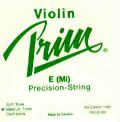 Prim
: Precision strings are
metal strings with a difference. They are rather warmer and thicker than the
average metal string, especially if you buy the blue ( soft ) label. Metal
strings do not suffer from corrosion by sweat and do not lose their pitch as
easily as gut / aluminium strings. I have tried a set of soft / low tension
Prims, but since the arrival of so many new synthetic strings, there seems no
need to have to resort to metal. However, I recall that I did not dislike this
make of string - but neither did I continue using it. Final mark 6/10
Prim
: Precision strings are
metal strings with a difference. They are rather warmer and thicker than the
average metal string, especially if you buy the blue ( soft ) label. Metal
strings do not suffer from corrosion by sweat and do not lose their pitch as
easily as gut / aluminium strings. I have tried a set of soft / low tension
Prims, but since the arrival of so many new synthetic strings, there seems no
need to have to resort to metal. However, I recall that I did not dislike this
make of string - but neither did I continue using it. Final mark 6/10
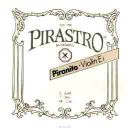 Pirastro
: Piranito strings. Soft
metal string that you would never believe are metal ! These are quite good - I
use them on small sized violins as a cheaper alternative to Dominant. I was
given a 1/4 size instrument with these strings on - and oddly enough - also have
them on a half size violin. Like Dominants, I think you can get these strings in
all the different sizes. They are slightly more corrosion resistant, and project
a very large sound. Recommended for instruments that need something more
powerful than Dominant. Final mark 7/10
Pirastro
: Piranito strings. Soft
metal string that you would never believe are metal ! These are quite good - I
use them on small sized violins as a cheaper alternative to Dominant. I was
given a 1/4 size instrument with these strings on - and oddly enough - also have
them on a half size violin. Like Dominants, I think you can get these strings in
all the different sizes. They are slightly more corrosion resistant, and project
a very large sound. Recommended for instruments that need something more
powerful than Dominant. Final mark 7/10

 D'Addario
: Zyex. These strings are made out of
Zyex. Zyex, invented in England, is a product of aerospace technology, designed
for the most extreme conditions of space - and this totally new molecular
structure is perfect for use in musical instrument strings. These strings are
tense ! The G string is enormously powerful, but feels as tight as an E string.
The E string is a rather lovely carbon based string, with a very soft and broad
sound ( compared to gold plated strings ). It never whistled from a bad contact
with the bow ( Unlike some Gold plated steel Es ) . The D and a Strings have a
slightly space age tone ( slightly empty and flat ), but the purity and power of
the sound is definitely good. There were many exciting things about these
strings, after playing on Eudoxas all my life, but the differences were so high,
I didn't want to spend the time to adapt to this new type of string. The
break-in time of this string is very short, and had I known they were so tense I
would have chosen the soft / low tension brand. This is a good string, but one
problem I had was playing piano. It seemed that a light stroke produced a huge
booming sound, just as a medium or heavy bow stroke. Undoubtedly this can be
used positively, in so far as a "Concerto" type tone is produced quite
effortlessly. I also found that the high tension caused notes in the middle of
the fingerboard ( say 5th position ) that would be muddy in sound on Eudoxas ,
here, were quite pure and healthy. Intonation was also clearer and purer on the
whole due to the more focused tension of this string. Final mark 7/10
D'Addario
: Zyex. These strings are made out of
Zyex. Zyex, invented in England, is a product of aerospace technology, designed
for the most extreme conditions of space - and this totally new molecular
structure is perfect for use in musical instrument strings. These strings are
tense ! The G string is enormously powerful, but feels as tight as an E string.
The E string is a rather lovely carbon based string, with a very soft and broad
sound ( compared to gold plated strings ). It never whistled from a bad contact
with the bow ( Unlike some Gold plated steel Es ) . The D and a Strings have a
slightly space age tone ( slightly empty and flat ), but the purity and power of
the sound is definitely good. There were many exciting things about these
strings, after playing on Eudoxas all my life, but the differences were so high,
I didn't want to spend the time to adapt to this new type of string. The
break-in time of this string is very short, and had I known they were so tense I
would have chosen the soft / low tension brand. This is a good string, but one
problem I had was playing piano. It seemed that a light stroke produced a huge
booming sound, just as a medium or heavy bow stroke. Undoubtedly this can be
used positively, in so far as a "Concerto" type tone is produced quite
effortlessly. I also found that the high tension caused notes in the middle of
the fingerboard ( say 5th position ) that would be muddy in sound on Eudoxas ,
here, were quite pure and healthy. Intonation was also clearer and purer on the
whole due to the more focused tension of this string. Final mark 7/10
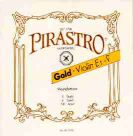 Pirastro
: Gold. These are
similar to Eudoxas, though slightly less expensive. I have tried them in the
past, but I don't recall any difference from the Eudoxas. The E string is nice
and soft, and you can replace it often when the gold plating wears off. Final
mark 7/10
Pirastro
: Gold. These are
similar to Eudoxas, though slightly less expensive. I have tried them in the
past, but I don't recall any difference from the Eudoxas. The E string is nice
and soft, and you can replace it often when the gold plating wears off. Final
mark 7/10

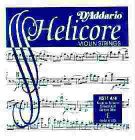 D'Addario
: Helicor
( I have never tried these but .... An Internet friend reports : ) This
relatively new entry from D'Addario has been well received.Quick bow response on
a warm, full bodied, sound ( unusual for a steel core string. ) Helicores have
the following characteristics: Multi-strand high carbon twisted steel core,
Wound with exotic alloys like titanium and tungsten, Warm, rich sound,
remarkably similar to gut core strings, Extremely quick bow response;
unprecedented ease of bowing, Subtle under the ear, yet carry great projection
in concert halls, Very long playing life, extremely stable under all playing
conditions -- Of course, like with all violin strings, how well they do depends
on your instrument. I've had some instruments that simply didn't do well
with Helicores. However, my current instrument, a well-made contemporary
violin, responds quite well to them, especially the heavy gauge. Mark
O'Connor has endorsed the heavy gauge, and I can see why. Unlike most
heavy-gauge strings, the Helicore variety has quick response as well as volume,
yet maintains a warm sound. I decided, though, to stay with the medium
gauge for now because the heavies were difficult to play without lowering the
bridge, something I don't want to do, at least for now. In my opinion, Helicores
offer the advantages of steel without the harshness. They also are the
best all-around string I've tried, suitable for classical, jazz, and folk
playing. Again, the results you get depend on your instrument.
D'Addario
: Helicor
( I have never tried these but .... An Internet friend reports : ) This
relatively new entry from D'Addario has been well received.Quick bow response on
a warm, full bodied, sound ( unusual for a steel core string. ) Helicores have
the following characteristics: Multi-strand high carbon twisted steel core,
Wound with exotic alloys like titanium and tungsten, Warm, rich sound,
remarkably similar to gut core strings, Extremely quick bow response;
unprecedented ease of bowing, Subtle under the ear, yet carry great projection
in concert halls, Very long playing life, extremely stable under all playing
conditions -- Of course, like with all violin strings, how well they do depends
on your instrument. I've had some instruments that simply didn't do well
with Helicores. However, my current instrument, a well-made contemporary
violin, responds quite well to them, especially the heavy gauge. Mark
O'Connor has endorsed the heavy gauge, and I can see why. Unlike most
heavy-gauge strings, the Helicore variety has quick response as well as volume,
yet maintains a warm sound. I decided, though, to stay with the medium
gauge for now because the heavies were difficult to play without lowering the
bridge, something I don't want to do, at least for now. In my opinion, Helicores
offer the advantages of steel without the harshness. They also are the
best all-around string I've tried, suitable for classical, jazz, and folk
playing. Again, the results you get depend on your instrument.
 Corelli
: Crystal & Alliance
- Crystal are of Perlon core, and available in three tensions.
Medium/Light, Medium, Forte. Alliance is made from a new formula synthetic core
which provides a playing life two or three times longer than other synthetic
strings. Corelli Alliance, along with Zyex and Obligato are three of a kind.
They are all 3 expensive, and can be considered an upgrade from Dominants.
However, the Dominants retain a looser tension rounder sound and thicker string
than these, so they are quite a different type of string. Crystals have a
Stabilon (Perlon) core, aluminum and silver wound. The warm sound of these
affordable strings can help out an instrument that sounds a little too bright.
Alliance have a Stabilon ( Kevlar ) core, aluminum and silver wound. The sound
is brilliant, rich and complex. These fine strings may cost more but they have a
great sound and last longer than most synthetic strings
Corelli
: Crystal & Alliance
- Crystal are of Perlon core, and available in three tensions.
Medium/Light, Medium, Forte. Alliance is made from a new formula synthetic core
which provides a playing life two or three times longer than other synthetic
strings. Corelli Alliance, along with Zyex and Obligato are three of a kind.
They are all 3 expensive, and can be considered an upgrade from Dominants.
However, the Dominants retain a looser tension rounder sound and thicker string
than these, so they are quite a different type of string. Crystals have a
Stabilon (Perlon) core, aluminum and silver wound. The warm sound of these
affordable strings can help out an instrument that sounds a little too bright.
Alliance have a Stabilon ( Kevlar ) core, aluminum and silver wound. The sound
is brilliant, rich and complex. These fine strings may cost more but they have a
great sound and last longer than most synthetic strings
Others to come :
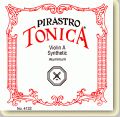

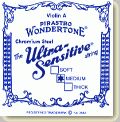
John Pearse Artiste : A new and fabulous string.
Considered by some to be the best string for any price. John's unique bonded
molecule formulation gives these strings a majestic sound, immediate response,
and projection not found in typical perlon core strings. The price is also good.
!

Hints & Tips :
Casa del Sol : - Link
to tips on string maintenance - good article
String Cleaner : You can order special
string cleaner ( Art. No. 912800 ) from Pirastro
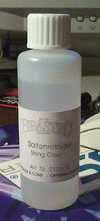
 Your
bridge : You may not know that you need a higher bridge for
lower tension gut core strings / or put the other way ; you need a lower bridge
for tighter metal or synthetic strings. The higher bridge compensates for the
lesser tension of gut core strings. Similarly, your curvature can be flatter the
tighter the strings. If your strings are not very tight or tense, as they bend
due to the weight of the bow hair contact, some curvature will be lost - so you
need more curvature. In general I prefer as flat a bridge as possible in order
to play chords in a less "broken" fashion - i.e.. all notes in the
chord should sound as "one" as much as possible. The concept of a
"flat" bridge is mostly for experts who tackle solo Bach, and have
very accurate bowing which does not "hit" adjacent strings easily
during single note détaché. Here are some pictures of my previous two bridges,
made by Bruce Carlson in Cremona, Italy. ( Click picture to zoom in )
Your
bridge : You may not know that you need a higher bridge for
lower tension gut core strings / or put the other way ; you need a lower bridge
for tighter metal or synthetic strings. The higher bridge compensates for the
lesser tension of gut core strings. Similarly, your curvature can be flatter the
tighter the strings. If your strings are not very tight or tense, as they bend
due to the weight of the bow hair contact, some curvature will be lost - so you
need more curvature. In general I prefer as flat a bridge as possible in order
to play chords in a less "broken" fashion - i.e.. all notes in the
chord should sound as "one" as much as possible. The concept of a
"flat" bridge is mostly for experts who tackle solo Bach, and have
very accurate bowing which does not "hit" adjacent strings easily
during single note détaché. Here are some pictures of my previous two bridges,
made by Bruce Carlson in Cremona, Italy. ( Click picture to zoom in )
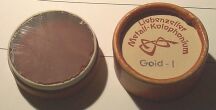 Your
Rosin : I use a rosin from Germany with Gold particles in it. (
GOLD 1 ) It costs the Earth, but it really is so adherent - you feel your bow
hairs glued to the string in such a way that it is almost difficult to pull the
two apart ! This is obviously good for the sound. The tone quality is so rich
and full when using this rosin. I estimate it is 3 to 4 times better than
anything else. The maker is Renate Schmidt, and metal particles ( such as gold
and silver ) are used in the rosin to give different tonal results. Effectively
you play with gold dust......I call this my "Magic rosin". It is
interesting how Pirastro advertise different rosin blends for their different
strings. This shows how critical the whole business is ! With a cheap, powdery,
yellow, Chinese rosin you obtain no adherence and a lot of powder - and no body
to the sound. The main purpose of rosin is to roughen bow hairs so they adhere
and grip the string, displacing it so that it vibrates. It connects the bow
hairs to the string. This is an important stage in sound production - do not
economize here ! Use this rosin sparingly - as it deposits a crust on the string
( cleaner needed !! ) . If you want this Rosin write to Renate M Schmidt,
Johannes Kepler Strasse 74, D-75378 Bad Liebenzell - Ul. , Germany - Tel
0049.7052.2904. ( this is a FAX and a PHONE number ) I cannot recommend it strongly enough - it is amazing !!
Your
Rosin : I use a rosin from Germany with Gold particles in it. (
GOLD 1 ) It costs the Earth, but it really is so adherent - you feel your bow
hairs glued to the string in such a way that it is almost difficult to pull the
two apart ! This is obviously good for the sound. The tone quality is so rich
and full when using this rosin. I estimate it is 3 to 4 times better than
anything else. The maker is Renate Schmidt, and metal particles ( such as gold
and silver ) are used in the rosin to give different tonal results. Effectively
you play with gold dust......I call this my "Magic rosin". It is
interesting how Pirastro advertise different rosin blends for their different
strings. This shows how critical the whole business is ! With a cheap, powdery,
yellow, Chinese rosin you obtain no adherence and a lot of powder - and no body
to the sound. The main purpose of rosin is to roughen bow hairs so they adhere
and grip the string, displacing it so that it vibrates. It connects the bow
hairs to the string. This is an important stage in sound production - do not
economize here ! Use this rosin sparingly - as it deposits a crust on the string
( cleaner needed !! ) . If you want this Rosin write to Renate M Schmidt,
Johannes Kepler Strasse 74, D-75378 Bad Liebenzell - Ul. , Germany - Tel
0049.7052.2904. ( this is a FAX and a PHONE number ) I cannot recommend it strongly enough - it is amazing !!